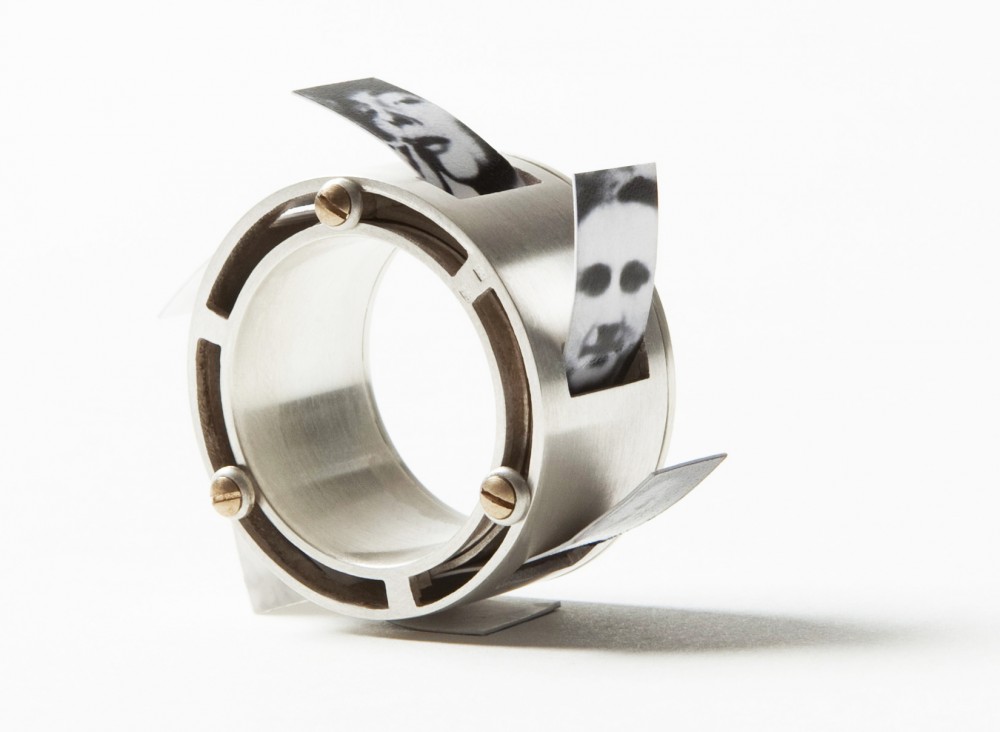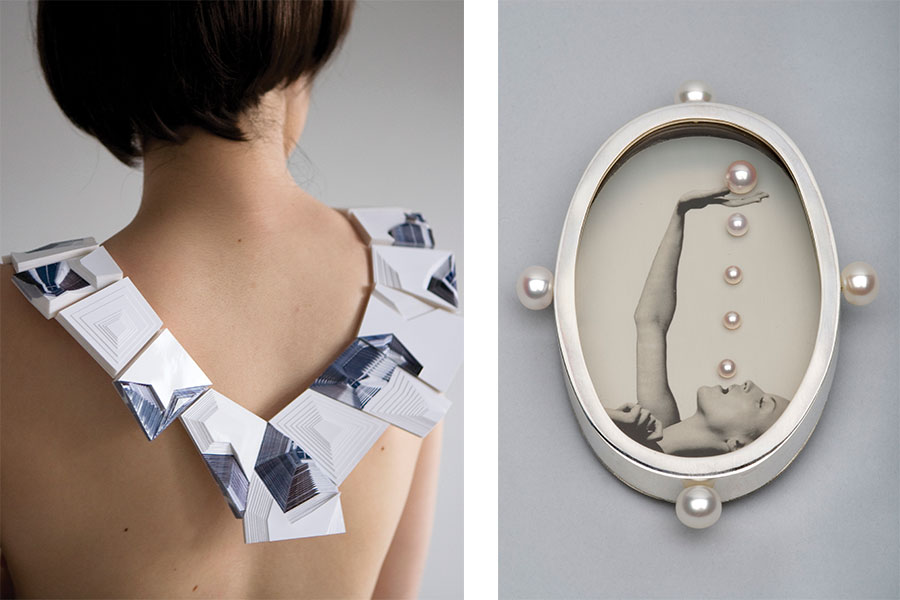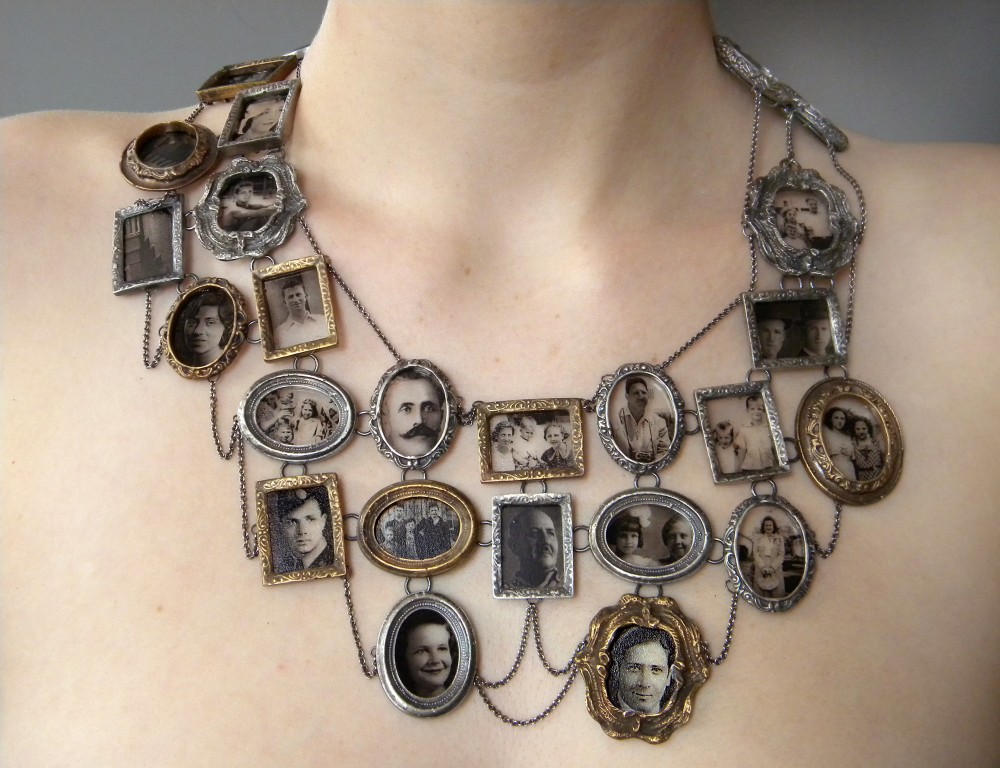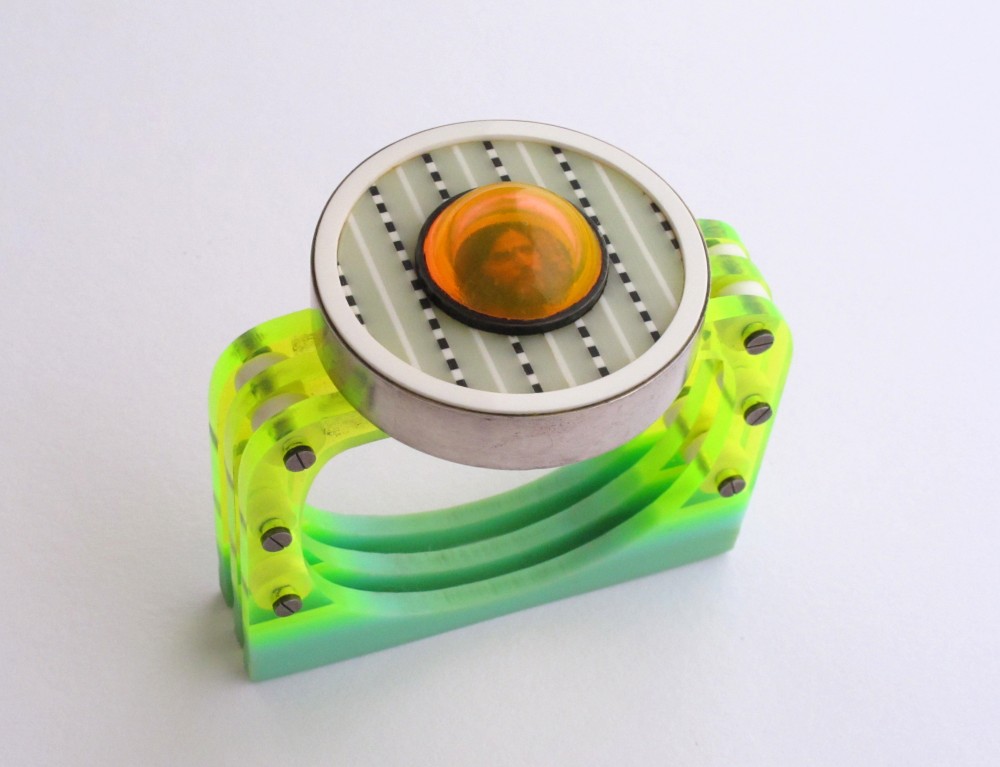What was the initial idea behind “Multiple Exposures?” The spark that generated this exhibition was ignited four years ago when I opened a family locket to find a photograph of my great-grandmother that I had not known was there.
This chance discovery spurred me to seek out contemporary examples and I soon realized the growing interest on the part of jewelry artists to incorporate photographic images in order to expand their artistic vocabulary and enrich their work.

How does contemporary jewelry relate to contemporary art?
Contemporary art jewelry is concept driven in which the ideas are as relevant as in the fine arts. Contemporary issues are dealt with such as politics, the human body, beauty, man’s interaction with the environment, social interactions, personal identity, consumerism, etc. as well as formalist concerns with color, space, mass, which are, of course jewelry has in common with the fine arts.
In jewelry one has the added attribute of having an intimate relationship with the body. The work of jewelry is not complete until it is selected and worn, connecting the wearer to the maker and bringing the work into the public realm—in many ways a form of public art.
Contemporary jewelry artists have clearly demonstrated that they can freely use any materials with unprecedented freedom and innovative techniques to create works that can be precious or, non-precious, narrative or abstract, decorative or grotesque—even bordering on the repulsive—highly personal or socially relevant. Alongside their colleagues in painting and sculpture, what is referred to as studio, art or author’s jeweler conveys ideas and concepts reflecting on today’s personal, cultural and global concerns in works using virtually unrestrictive forms, materials and techniques within the limits imposed by wearability.
For example, the portrayal of personal, social and cultural relationships is a central concert to many contemporary jewelry makers. Through work they reflect on close connections to families and friends, provide commentaries on the nature of celebrity and infamy and encourage us to conjure up our own histories on gazing at anonymous portraits of lost identities. The culling of portraits from a seemingly infinite number of sources from the past and present, the local and exotic, begins a process of transforming and endowing them with new meaning that reflect on the role of jewelry as well and of jewelry making.
Since the works in Multiple Exposures are primarily content driven, the exhibition was organized into subjects that commonly appear in the fine arts including photography: portraiture, landscape, and the figure, but with a contemporary sensibility. Other sections focus on pieces using approaches characteristic of such twentieth- and twenty-first-century artistic practices as recycling and repurposing; the appropriation of images from art and popular culture; and the cultural role and performative aspects of jewelry are explored through still and moving images without dependence on the physical object.
Please see my essay for a fuller explanation.
What does jewelry express that other forms of contemporary art cannot?
One example is how jewelry artists treat the body. The human form is a source of inspiration for jewelry artists who address the broad spectrum of contemporary concerns about the body and identity with representations from the literal and figurative to the symbolic and metaphoric. Wearing jewelry actually increases our consciousness of the visceral, physical and temporal nature of the body and provides tangible reality to our existence as biological organisms and social individuals. As noted above, jewelry is at once personal and intimate as well as presented by the wearer in a social context, rather than in a gallery or museum. The artist’s ideas are very closely connected to the wearer; to some degree the wearer connects very directly with the artist’s ideas through the mere fact of wearing the piece.

Why use photos in jewelry design?
The act of wearing an image integrated into an intimate form makes a profound and immediate impact on the wearer and viewer. In tandem, jewelry and photography are providing unique insights into today’s increasingly visual and rapidly shifting cultural terrain. With the plethora of images available on the Internet, on television, YouTube, etc., the messages within the images is often lost or ignored. By culling images from the virtually unlimited number sources and by incorporating them into jewelry, the jewelry artist makes the message become meaningful again. There is this symbiotic relationship between object and image and photo-jewelry—the hybrid form created—alters the original intent of the image through the new perspective introduced by the artist.
What purpose does jewelry serve today that is unique to our time?
When worn, a piece of jewelry sends messages about the attributes and character of the wearer that depend on and change with the contemporary social context. The cultural and performative facets that are inherent in how jewelry is perceived and thus conceived are an expanding area that is being explored by artists apart from encounters with the tangible object itself.
Many artists are drawn to the photography for its potential to transmit ideas about jewelry and the act of wearing it. Their focus has shifted from making beautiful objects to revealing the conceptual, less physical aspects of the medium. In their photographic explorations, the question “But is it jewelry?” is not relevant, since art jewelry is rapidly evolving even as conventional jewelry remains a status symbol – diamonds are a girl’s best friend, but for there is a new and expanding class of jewelry that is rich in content and increasingly relevant in the search for personal expression in an depersonalized society. We are also beginning to see a merger of technology and adornment that will challenge our concept of jewelry and its intimate relationship with the individual.
Artists are taking a broader, more conceptual approach to challenge traditional notions of what jewelry should be: a wearable, decorative object. With video jewelry artists explore wider-ranging themes: for example, the rituals involved with wearing jewelry and its significance as a wedding ring; the tension created by too much gold and precious stones can become restricting and a burden; the commercialization of well-known brand names through the lure of the logo, standing in place of the craftsmanship and creative ideas originally present in the works. The short videos by trained goldsmiths in the exhibition represent intriguing new ways to express such ideas about the concept of jewelry.
How can we see this in “Multiple Exposures?”
Examples in the exhibition include Sarah Turner’s If One Could Wear a Marching Band, a necklace projected on the body that freed her from dependence on physical objects and the images through which they are perceived. Going beyond real world constraints, she invites us to imagine a world where one could actually wear a full marching band. Such projections do not just document a performance or a once-existing jewelry object, they expand jewelry into an era of visual excitement in which the glitter and sparkle of gems have been replaced by dynamic imagery, which may be the vanguard of a new direction in wearable light and color.
Spanish artist Ramon Puig Cuyas explores the way we perceive the world in his UTOPOS Brooch No. 1279. He questions whether scientific thinking is more “accurate” than an artist’s intuition by visually contrasting the Renaissance Humanism represented by the eye in Ghirlandaio’s 1485 painting Portrait of a Young Woman with a visualization of Einstein’s gravity field. Puig Cuyas argues that since “rational science” has had to accept uncertainty as a fundamental principle, perhaps it is time to accept the value of the insight of artists in charting our place in the cosmos. It is remarkable to find these profound and challenging thoughts encapsulated in a small wearable object.

What sparked your love of jewelry?
I originally was trained in the history of the decorative arts and was ultimately attracted to jewelry as perhaps the most personal art form where a great deal can be expressed on a small scale. It is both decorative and sensitive to the human body, but it is sculptural and very often content driven. Even those pieces that are abstract are rich in the choice of materials and techniques that must conform to the body.
But above all I love to get to know the artists. One of the great pleasures of curating contemporary works is the relationships you build with artists and craftsmen (and craftswomen). You follow the development of mature artists and discover and even nurture young, emerging artists. I have witnessed the spread of contemporary jewelry from the US and Europe to Japan, Australia, South Africa and South America and the infusion of new approaches, often reflecting different cultures, is a constant and invigorating source of pleasure.
Why did you decide to focus on jewelry?
Art Jewelry is a living, vibrant field that has grown internationally to encompass an enormous range of ideas, materials and techniques. The artists conceive and masterfully create unique works that are not intended for a mass audience or presentation on a wall in gallery, but for an individual who shares their concepts and realization. By inviting viewers to react and interpret their creations from both universal and personal perspectives, contemporary jewelry artists establish a collaboration between maker and wearer that just may be the strongest such bond in the art world.
What is unique about MAD's collection of jewelry?
It is the oldest museum collection of this type of jewelry in this country. We began collecting when the museum first opened in in 1956.. We have the most important collection of mid-century American studio jewelers including Sam Kramer, Art Smith, Margaret De Patta, Ed Weiner, Paul Lobel, etc. During the last 20 or so years, we have collected works by international art jewelers and greatly expanded our vision. We also collect drawings related to the works as well as interviews of jewelry artists who speak about their work and demonstrate the process. We track mature artists over the course of their careers and continually acquire their latest works and we constantly search out works by emerging artists as well as works that include new technologies and materials.

How has the relationship between photography and jewelry evolved since the invention of photography?
Almost at the invention of photography in the late 1830s, jewelry and photography were united. Early photography replaced painted portrait miniatures which were worn by the aristocracy and the very wealthy. Photography replaced these miniatures and made wearing the portrait of a loved one possible for the middle classes. The pieces were initially worn as tokens of affection, love, or mourning.
Photographic images today transmit visual clues that jewelry artists weave into narratives that invite interaction with the viewer. As we are become inured to seeing scenery and people in miniature versions on smart phones and computer screens, it is increasingly rare to hold a photograph in our hands. Jewelry adds the lost sense of touch to appreciation of flat images, endowing them with the distinctive mark of the maker’s hand that establishes a separate reality that, in many cases, is independent of fidelity of the image to the actual subject. At a time when everyone is staring into their cell phones to record a moment for the future rather than enjoying the moment in the present, art jewelry makers contribute a vital and important new aspect to the photographic experience,.
Recognizing that perception is intricately bound with an individual’s sensibility and background, and taking advantage of this fact rather than viewing it as a shortcoming, contemporary jewelry artists select and manipulate images from today’s virtually infinite supply. Harnessing the visual clues and symbols contained within them, and carefully working them into one-of-a-kind settings, they develop alternate realities expressive of their own aesthetic sensibilities, beliefs, values, and emotions, as well as current cultural and global concerns. The distinctive mark of the maker’s hand introduces a fresh framework and context for each photograph—whether an early daguerreotype, a vintage snapshot, or a recent digital image—and establishes a narrative that, in many cases, does not depend on fidelity to the actual subject.
What are your plans for your upcoming sabbatical?
I am scheduled to travel to China to jury for the World Craft Council’s 50th Golden Jubilee Celebration Summit. I will lecture in Korea on paper jewelry and dress. Lecturing in Goteborg, Sweden on Multiple Exposures. Writing articles on contemporary jewelry and preparing two new jewelry exhibitions for Korea and Italy in 2016 and 2017. Finally, I am looking forward to spending more time in Munich, my home town which, coincidentally, has become an international mecca for contemporary jewelry. I will also squeeze in some time off to see what it feels like to sleep in once in a while.


